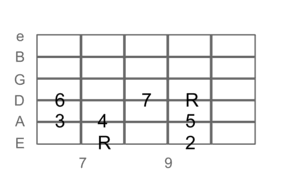
It’s time these guitar students learn music theory. Life can’t just be about noodling and trying to figure out, Smoke on the Water. If this sounds like you, you’re not alone – we agree. However, it might surprise you to learn that teaching music theory on guitar is just about the easiest thing in the world. That’s because guitar is so Shape and Pattern driven.
Check out these three fundamental concepts that will have your kids on point with music theory before you can sing, Doe a Dear.
Major Scales

You can teach the major scale as “W W H W W W H”, but what if you added a picture like this? The beauty of guitar is that you can use this Shape or Pattern all over the guitar. The only rules you have to follow are: 1. Start by putting your middle finger on a fret on the Low E or A string. 2. Your first note cannot be an open string – eg, Low E on the Low E string. 3. The note where you put your middle finger is the name of the major scale.
Minor Scale

On a more serious note – you can teach the minor scale as “W H W W H W W”, but what if you added a picture like the one above? Again, as long as your students know the Pattern/Shape they can play any minor scale. This one has rules, as well: 1. Put your index finger (your first note) on a fret on the Low E or A string (your first note can be an open string, but you would not put your index finger down in this case). 2. The note where you put your index finger is the name of the minor scale you’re playing.
Intervals
So much of music is about Do – Sol – Do. It’s the place you start, the place you go, and the place to which you return. Throw in a 3rd – major or minor – and you have a chord. So, it’s imperative that your students get to know where the Do of the scale is in relation to Sol. How do you make it happen? On guitar, look no further than the power chord Shape! Take a look at these power chord Shapes. Notice the pattern?
1. Put your index finger down – Do.
2. Move 2 frets horizontally and one string vertically (to the next highest string) and put your ring finger down – Sol.
3. Move one string vertically (to the next highest string) and put your pinky finger down – Do (Octave).
Caveats: 1. Put your index finger on any note on the Low E or A. 2. If you want your first note to be an open string, your ring and pinky will wind up on the second frets and, naturally, you don’t hold down an open string with your index finger.
